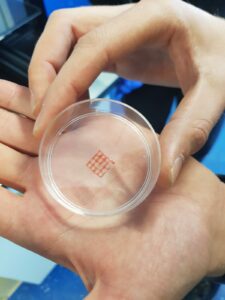Meet the researcher: algae, sea bass and 3D printing with Diana Marques
24 January 2022
Don’t be afraid to reach out – that’s the advice from a researcher developing new techniques to cultivate fish fillets.

Name: Diana Marques
Job title: Scientific researcher
Organisation: Institute for Bioengineering and Biosciences, University of Lisbon
Sustainable protein specialism: Cultivated seafood
Don’t be afraid to reach out – that’s the advice from a researcher developing new techniques to produce cultivated fish fillets.
Diana Marques is a key member of the team led by Associate Professor Frederico Ferreira from the University of Lisbon’s Institute for Bioengineering and Biosciences (iBB).
Making fish from algae
The project aims to cultivate sea bass cells, creating a real fish fillet with the same look, taste and texture as conventionally produced sea bass – and even the same health benefits – without the bones, negative environmental impact, or microplastics.

The team is using techniques including 3D printing to create edible scaffolds using material extracted from algae and plants, giving structure to a product cultivated from fish cells.
Diana first became interested in cultivated meat – which she had never previously heard of – when she was taking part in an entrepreneurship course led by Professor Ferreira as part of her biotechnology masters programme at Lisbon’s Instituto Superior Técnico.
The course encouraged students to come up with ideas for startup projects and Diana’s team developed the concept of creating cultivated sushi.
“The moment I found out what I wanted to do with my life”
Diana said: “I’m a vegan, so when I discovered that I could take something I feel passionate about – food and sustainability – and combine it with science, that was the moment I found out what I wanted to do with my life.
“I really want cultivated meat to happen, so now I’m motivated every day to create a product that will work. It’s really nice to be working on something so innovative.”
She approached Professor Ferreira, who had a background in biomedical scaffolding, and between them they developed what became the cultivated sea bass project the team is now working on.
She devoted her masters thesis to creating the algae and plant-based bio-inks now being used in the 3D printing process, and spent her time trawling the Good Food Institute website – which she says contains “everything a person needs” to learn about the science of cultivation – and attending online seminars.
“Don’t be afraid to reach out”
It was at this point that she contacted GFI’s senior scientist Dr Claire Bomkamp, who she had seen presenting a cultivated seafood seminar, and went on to apply for GFI’s Competitive Research Grant Programme, which is now funding the project.
Diana said: “My advice to researchers who are interested in this field is don’t be afraid to reach out. Cultivated meat is at a very early stage and I think the research community is really open to hearing people’s ideas.
“But I also think we need to establish more significant communication around cultivated meat research, with optional courses at universities, so people have got more background knowledge and are more likely to enter the field.”
Are you interested in getting involved in the sustainable proteins field? Take a look at our resources.
If you’re a researcher:
- To find funding opportunities, check out our research funding database for grants from across the sector, and our research grants page which showcases funding available from GFI.
- Explore our Advancing Solutions initiative, which highlights the main sustainable protein knowledge gaps, and subscribe to the collaborative researcher directory, which provides details of potential collaborators or supervisors with a stated interest in the field.
- Find out about research projects that have already been funded on our research grants tracker or our grantee web pages.
- Look out for monthly science seminars run through our GFIdeas community or use our company database to identify commercial partners.
If you’re a student:
- Find educational courses around the globe through our database.
- Sign up for our free online course introducing the science of sustainable proteins, explore our resource guide explaining what is available to students, and check out our careers board for the latest job opportunities in this emerging field.
